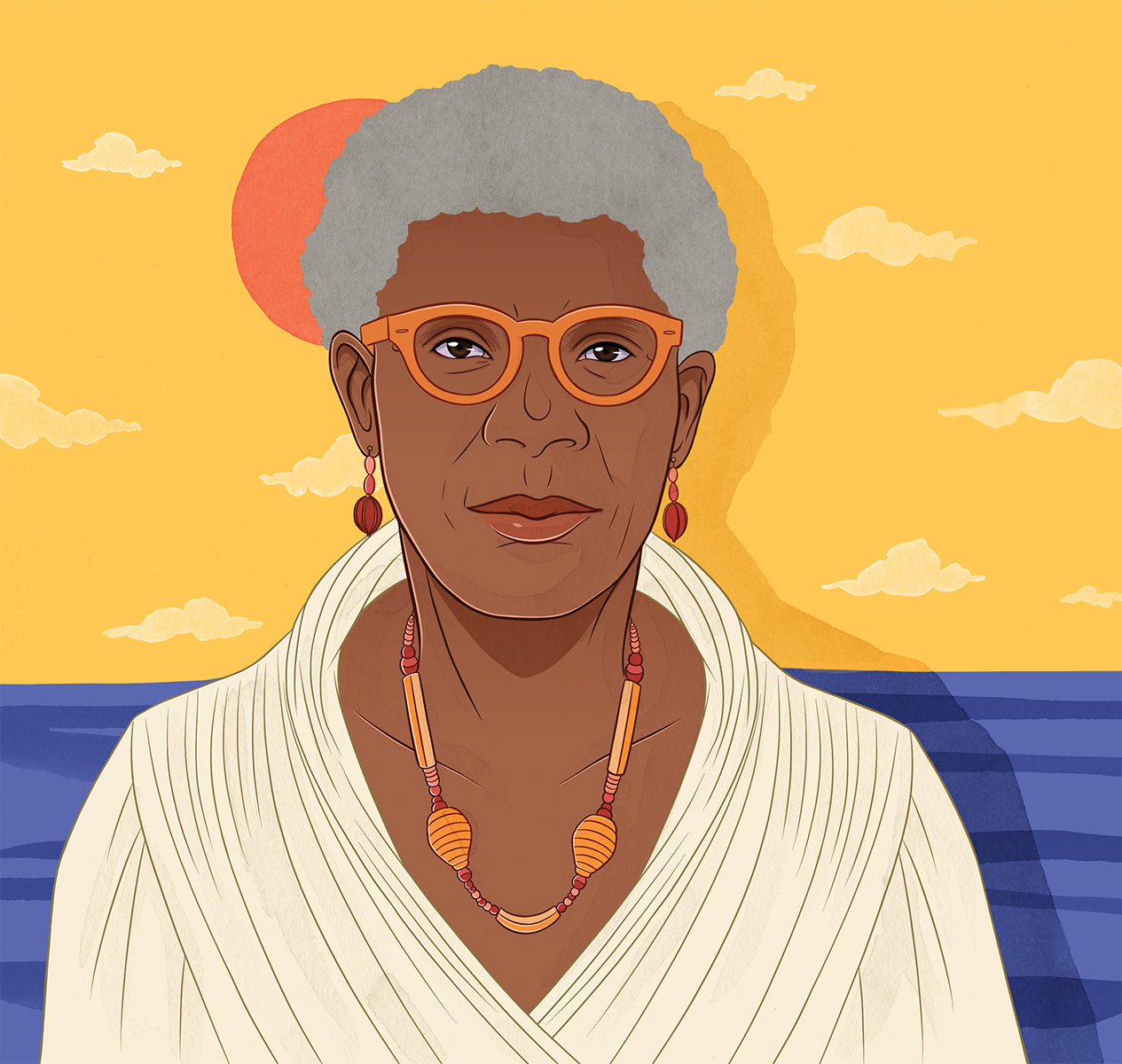They kill the women and the children first. This is the most cost-effective decision. The captain knows by heart the commodity value of a child, knows the women will be worth less than the men at the auction block. So he picks the obvious choices: he orders the crew to push them, the women and the children, through the cabin windows and into the Atlantic.
It’s September 1781, and having departed the Guinea Coast for a sugar port in Jamaica, the Zong is overloaded with enslaved Africans. Because the captain lacks navigational and command experience, the voyage will take eighteen weeks instead of the usual six; the ship will run low on drinking water; slaves and crew members will take ill and die; the captain will become desperate. Soon enough, he will compensate for his mediocrity with quick and murderous calculations. Over the course of ten days, to conserve resources, he and his crew will sacrifice Africans to the sea—according to some sources, it may have been as many as 150. When the ship docks in Jamaica, the captain will file an insurance claim for the loss of his “cargo.”
Here is how a massacre enters history: as a story of property destruction.
In 2008, the Toronto-based writer M. NourbeSe Philip published a dizzying, fragmented book-length poem entitled Zong!: As Told to the Author by Setaey Adamu Boateng, a seven-year archival project that bears witness to those atrocities and attempts, as the author says, to “defend the dead.” She composed and rearranged the text using words sourced exclusively from the two-page legal case report of the insurance claim she tracked down in the University of Toronto’s law library. In time, Zong! became a widely studied work of contemporary literature, performed dozens of times in at least nine countries and excerpted in arts galleries globally. Critics have described it as a masterpiece.
In early 2016, Philip received an enthusiastic email from a woman called Renata Morresi, a translator and poet who teaches American literature at the University of Padua in Italy. Morresi wanted to translate Zong! into Italian. Her academic research focused on, among other subjects, “slavery and its ‘unconventional’ representations,” and she had been recently awarded Italy’s national prize for translation. She thought Zong! could be valuable to Italians who were striving to make sense of their own contemporary crisis. That year alone, CNN reported, an estimated ninety migrants from North Africa and other Arab countries were drowning every week in the Mediterranean in their bid to escape violence, poverty, persecution, and war. Morresi did not, at the time, have a publisher for the translation or a contract or anything in the way of a plan, and Philip felt the emails gave the enterprise the feel of an unserious project. She advised Morresi to contact Wesleyan University Press, the book’s American publisher, which owned rights to Zong!
“I don’t know whether you speak Italian,” Morresi wrote to Philip, “but if you feel like we can discuss the drafts (it would certainly be an invaluable help for me).”
The next time Philip heard from anyone about the Italian translation of Zong! was five years later, when a small Italian publisher called Benway Series emailed the proofs with an invitation to the book’s online launch. It came as a surprise. Neither Morresi nor Wesleyan had informed her that a formal agreement was signed and subsidiary rights to her book transferred. By then, two other translators had joined the project. The translation was supported by the Canada Council for the Arts, a public funder that serves Canadian artists and arts organizations, but the $13,350 it paid Benway Series had likewise changed hands without the artist’s knowledge. (Part of the CCA’s literary translation program serves international publishers.)
The lack of transparency confused her: it’s professional practice to involve the poet in any translation work. She emailed Suzanna Tamminen, the director and editor-in-chief at WUP, to confirm a contract had been signed, before congratulating the translators on their hard work. “I am honoured,” she wrote to Benway. “It is so important that this work reach European countries, many of which are the ground zero of the trauma that is ongoing.”
And then she saw what they had done to her book.
Literary translation is an unforgiving balancing act. The Italian saying “traduttore, traditore”—or, “translator, traitor”—captures how any translation is destined to obfuscate the true meaning of the original, sealing the fate of what Miguel de Cervantes in the seventeenth century called a work’s “original luster.” The consequence is both reader and author are betrayed. Vladimir Nabokov famously translated his own novels into Russian to avoid seeing them “degraded and botched by vulgar paraphrases.” He was deeply contemptuous of Constance Garnett, a translator who basically brought Russian literature to the English-speaking world, because by favouring readability, she often elided an author’s idiosyncrasies. If translators seem inclined to fatalism, in other words, it’s because they’re tortured by the idea that their aptitude will be measured by how invisible they can make themselves.
The translator’s presence in Zong!, though, was not quite the object of Philip’s distress; Philip is not a Nabokovian purist. Translators have worked on her books before, with her approval. The problem was of another nature. Among the myriad reasons Zong! has become such a widely studied work are its disjunctive, distinctive visual qualities—a kinetic form charged with spiritual intent. The poetry sweeps across 180 pages in the manner of vocal jazz or a disordered musical constellation. As if carried off by waves, words float away from each other, swirl around, casting off letters like articles of clothing; syllables gurgle or stutter, refuse meaning. Isolated phrases, seemingly at random, tilt into cursive or italics. Submerged at the bottom of each page are imagined African names for the drowned, whose deaths were originally recorded as “negroe man” or “negroe woman.”
It had taken Philip years to find this form. It wasn’t until after a 2006 sojourn to Ghana, the departure point of the slave ship, that the book’s organizational principle began to slowly reveal itself. That principle became associated with a figure she called Setaey Adamu Boateng, who represented the ancestral voices she believed were speaking through the pattern she was painstakingly creating on the page. “Every word or word cluster,” she wrote in the book’s closing essay, “is seeking a space directly above within which to fit itself.” Those spaces are critical for Philip, because they are intended to represent the very air the enslaved were denied as they sank. “The text is attempting to revivify and recuperate what was lost in those last breaths,” Philip told me. “That, for me, is nonnegotiable.”
When Benway Series sent her the proofs in June 2021, the first thing Philip noticed was that this nonnegotiable rule had been broken. The PDF on her computer screen felt cluttered and claustrophobic. The Italian phrases often nearly grazed the lines beneath them. The formal protocols she had painstakingly established to turn Zong! into what she called a “mourning song” had not been respected. Morresi had attempted to capture the poetry’s pictorial shape, but the translator not only missed the logic behind why the text had been arranged that way, she also failed to consider how that arrangement might need to change when adapted into a foreign language. “What I am committed to is that it’s a dynamic action,” said Philip, referring to Zong! ’s form. “The words have to be positioned in such a way that they breathe.”
When Philip raised these concerns in an email to Benway Series, she was rebuffed. Morresi, wrote the book’s editors, was “extremely skilled and multi-award-winning,” and a first draft of the translation had been anonymously peer reviewed “in very positive terms.” WUP’s head emailed to say it wasn’t part of the normal process to send authors permission updates about their books, and that, anyway, “expanding the critical discourse on the book in this way helps to ensure [it] remains on reading lists for years to come.” Morresi emailed to note that any differences between the source text and its translation were attributable to Italian’s cumbersome morphology: the words inevitably run longer, which made it difficult to adhere to Philip’s unique spacing rules. She would have reached out directly to ask questions, Morresi said, but she assumed Philip wasn’t interested, and she didn’t want to disturb her.
Morresi, to an extent, was right. Because translators always work creatively within the constraints of their own languages to convey the poetic force of the original, some degree of loss and transformation is inevitable. And it’s true that Italian produces longer words than English. But, since a big part of Philip’s issue with the translation was the spacing between words, it wasn’t altogether clear why that rule could not have been preserved with a different page format or font size.
After weeks of fruitless discussions, as it became obvious Philip would not consent to the translation, Benway Series went ahead with publication. In late August 2021, when Philip received word that the press was preparing to distribute the book, she demanded the publisher destroy it and scrub all mention of the title from their website. WUP’s Tamminen, now swayed by Philip’s concerns, supported the request. Benway Series refused. In an email signed by two editors, the press argued they had done everything according to the letter of the law. Philip went public on social media and drew the support of more than 1,200 people—among them, poets, editors, scholars, publishers, translators, and readers—who petitioned to have the “flawed” translation recalled and destroyed.
Benway posted a rebuttal on its website, in Italian, that described Philip’s demands as reminiscent “of authoritarian and fundamentalist regimes around the world” and said her accusations of racism were “offensive, not so much to us . . . as much as for all the victims of that gruesome violence.”
It seemed to Philip that Benway Series expected her to be grateful for their attention, that the virtuousness of a small Italian press ought to be celebrated rather than contested. But she couldn’t understand why nobody there thought to contact her about the translation. “Even if there weren’t those underpinning spiritual, historical reasons why the structure of Zong! is important,” she said, “as an artist and as a poet, surely my work must be respected.”
It’s difficult to know what legal recourse Philip had in this scenario. One interesting precedent might be what happened in 1982, when someone messed around with the artist Michael Snow’s work and ended up with a lawsuit. The developers and architect of the Toronto Eaton Centre had, years prior, commissioned Snow to make a permanent artwork they could hang in the skylit atrium, and in 1979, he completed the now world-famous Flight Stop, a Styrofoam and fibreglass flock of sixty Canadian geese paused midflight. To decorate for the Christmas season of 1982, the mall’s marketing director tied red bows around the necks of the hanging geese. They didn’t ask Snow’s permission and dismissed his subsequent protests as a tantrum. The artist filed an injunction to have the ribbons removed, arguing that the integrity of his work had been harmed; in a landmark Canadian decision, the Ontario Superior Court found the mall operators liable for violating the artist’s moral rights.
Moral rights stem from the Berne Convention, the leading international copyright treaty which states that even if an artist cedes economic rights to their work, they retain the legal grounds to “object to any distortion, mutilation or other modification” done to that work. One option, therefore, might have seen Philip
file a lawsuit against Benway Series in Canada and, if she won, go to an Italian court to help enforce it. Neither of these actions would have been easy to pull off.
While Italy appears to provide substantial legal protections to writers and artists, there’s very little Canadian case law on the subject, even though the Snow ruling raised the bar for moral rights infringement. “What it did was set a precedent that in order to win in a case of moral rights, you had to prove that it damaged the honour and reputation of the artist,” said Martha Rans, a Vancouver-based lawyer who specializes in copyright law. But there’s a caveat: you need a reputation big enough that any damage to it can be quantified. “It becomes very difficult to mount a case,” said Rans, “because Canada doesn’t have a lot of what might be considered high-profile artists.”
Which means winning a legal suit would be challenging for an “unembedded, disappeared poet and writer in Canada”—as Philip describes herself in her nonfiction collection Blank: Essays and Interviews. Philip’s first novel, Harriet’s Daughter, was published in England in 1988, after a string of rejections from Canadian presses that felt the all-Black cast of characters was unsuited for the local market. When Zong! was published, in 2008, it was almost unanimously ignored by Canadian reviewers, though it received widespread academic attention south of the border. And, until last year, when she was given a $50,000 Molson Prize by the CCA for her “invaluable contributions to literature,” Philip had yet to win any major prizes in Canada, despite having worked here for four decades as a writer. It seems ironic that while Philip’s work is notable enough to be taken up by a foreign publisher, she might be hard pressed to defend her moral rights in her own country.
None of this, of course, changes Philip’s belief that Benway Series severed her from her own book and that key decisions about the Italian translation had been made in rooms to which she had no access. This also isn’t the first time Zong! has found itself vulnerable to mistreatment. In 2017, Lebanese artist Rana Hamadeh emailed Philip for permission “to mention Zong! and point towards it” in an upcoming exhibition at the Witte de With Center for Contemporary Art in Rotterdam. Philip, whose sister was at the time dying of cancer, was unable to reply until a month later, at which point she explained she couldn’t adequately respond to Hamadeh’s request. “What I didn’t realize,” Philip said, “was that she had already used the work.”
Six weeks later, Hamadeh’s experimental opera, The Ten Murders of Josephine, opened. To many observers, it borrowed substantially from Philip’s research into the slave ship massacre as well as from the typographic layout she had created to bear witness to it. (WUP reportedly complained to the Witte de With Center that Hamadeh’s work constituted “an adaptation of Zong! ”) As The Ten Murders of Josephine picked up plaudits and went on to win a major arts prize from the Dutch government, seemingly the only attribution to Philip remained a passing remark in the visitors’ guide at the museum. The irony, as the scholar Kate Siklosi wrote in The Puritan, an online literary magazine, was that “Hamadeh’s work doesn’t just take an archive of erasure as its subject matter—by erasing Philip’s work, her work contributes to an ongoing archive of erasing Black presence and subjecthood.”
Months after Philip called for the Italian edition’s destruction, Benway Series hosted a performance of Zong! at an art gallery in Milan. A video on the publisher’s website shows a white ethnomusicologist playing traditional African instruments in a room decorated by photographs, each depicting a waxy Black face that seems threatened to be swallowed by the darkness around it. “And the performer—she was reading from the book, which, even in the Italian translation, still has the words broken up,” said Elena Basile, who translates between English, French, and Italian. “And what she was doing in the performance was putting the words back together, making them intelligible. She was reconstructing the sentences that the poem itself is undoing.”
Before it became a symbol of civilizational cruelty, the Zong bore the Dutch name Zorg, which translates, coincidentally, to care. It’s one of many small, chilling ironies tucked into the fabric of the cataclysm.
The Italian publisher never did back down. WUP, in a bid to remove the copies of the book from circulation, succeeded in buying up stock from some of the Italian bookstores that carried the title; other stores refused to sell. The book is now out of print, and as a result, the translation rights have reverted to WUP.
Philip sees her situation as a neat metaphor for something universal: the set of practices that keep dooming Black artists to the status of disposability. “It’s like when the West goes into Africa, sees the art, sees the culture, then literally seizes the physical artifacts and brings them home,” she said. How else to explain Benway’s expectation that, for $150, they could buy the rights to a book about the slaughter of 150 Africans, usurp its form, and deny the poet any ownership over the result? “It’s a move right out of the colonial playbook.”






